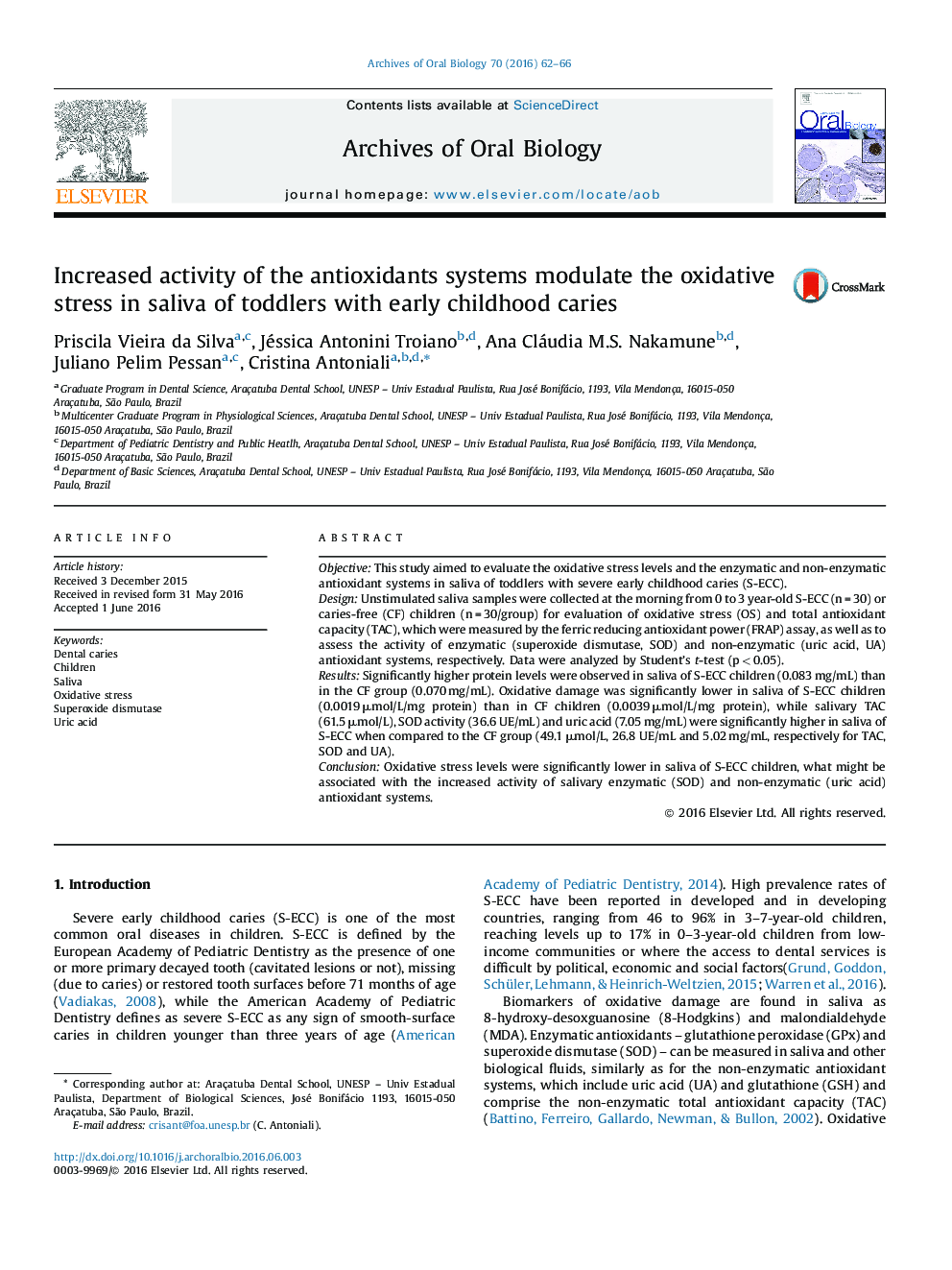| کد مقاله | کد نشریه | سال انتشار | مقاله انگلیسی | نسخه تمام متن |
|---|---|---|---|---|
| 3120600 | 1583283 | 2016 | 5 صفحه PDF | دانلود رایگان |
• High protein levels are observed in saliva of S-ECC children.
• Oxidative stress is decreased in saliva of S-ECC children.
• Total antioxidant capacity of the saliva is increased in S-ECC group.
• Enzymatic (SOD) antioxidant systems is increased in saliva of S-ECC children.
• Uric Acid, a non-enzymatic antioxidant system, is also increased in saliva of S-ECC.
ObjectiveThis study aimed to evaluate the oxidative stress levels and the enzymatic and non-enzymatic antioxidant systems in saliva of toddlers with severe early childhood caries (S-ECC).DesignUnstimulated saliva samples were collected at the morning from 0 to 3 year-old S-ECC (n = 30) or caries-free (CF) children (n = 30/group) for evaluation of oxidative stress (OS) and total antioxidant capacity (TAC), which were measured by the ferric reducing antioxidant power (FRAP) assay, as well as to assess the activity of enzymatic (superoxide dismutase, SOD) and non-enzymatic (uric acid, UA) antioxidant systems, respectively. Data were analyzed by Student’s t-test (p < 0.05).ResultsSignificantly higher protein levels were observed in saliva of S-ECC children (0.083 mg/mL) than in the CF group (0.070 mg/mL). Oxidative damage was significantly lower in saliva of S-ECC children (0.0019 μmol/L/mg protein) than in CF children (0.0039 μmol/L/mg protein), while salivary TAC (61.5 μmol/L), SOD activity (36.6 UE/mL) and uric acid (7.05 mg/mL) were significantly higher in saliva of S-ECC when compared to the CF group (49.1 μmol/L, 26.8 UE/mL and 5.02 mg/mL, respectively for TAC, SOD and UA).ConclusionOxidative stress levels were significantly lower in saliva of S-ECC children, what might be associated with the increased activity of salivary enzymatic (SOD) and non-enzymatic (uric acid) antioxidant systems.
In saliva of children (0–3 years) with severe early childhood caries (S-ECC) total protein levels are higher than in saliva of caries-free children. Oxidative damage, evaluated by TBARS, was reduced in saliva of S-ECC. This alteration was associated to increased total antioxidant capacity (TAC), evaluated by FRAP, in saliva of S-ECC children. Higher superoxide dismutase (SOD) activity and uric acid (UA), the enzymatic and non-enzymatic antioxidant systems respectively, contribute to the reduced levels of oxidative damage in saliva of S-ECC.Figure optionsDownload high-quality image (67 K)Download as PowerPoint slide
Journal: Archives of Oral Biology - Volume 70, October 2016, Pages 62–66
